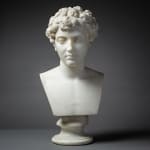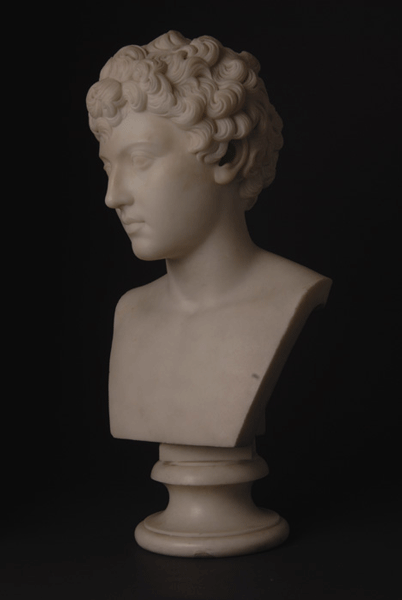Classical Revival Marble Bust of a Young Marcus Aurelius, 1820 CE
Marble
54.6 x 26.7 cm
21 1/2 x 10 1/2 in
21 1/2 x 10 1/2 in
X.0513
Further images
-
(View a larger image of thumbnail 1
)

-
(View a larger image of thumbnail 2
)

-
(View a larger image of thumbnail 3
)

-
(View a larger image of thumbnail 4
)

-
(View a larger image of thumbnail 5
)

-
(View a larger image of thumbnail 6
)

-
(View a larger image of thumbnail 7
)

-
(View a larger image of thumbnail 8
)

This beautifully rendered marble carving of the young Marcus Aurelius was made during or after the Enlightenment, in the spirit of the antique originals of ancient Rome. These pieces were...
This beautifully rendered marble carving of the young Marcus Aurelius was made during or after the Enlightenment, in the spirit of the antique originals of ancient Rome. These pieces were found during the Great Tours of the 18th and early 19th centuries, and inspired sculptors just as antique architecture was echoed in public buildings of the period. The base is a plain turned pedestal, with a sectional block of the torso slightly narrower than the shoulders. The face looks slightly to its right, wearing a pensive expression. The idealised features are serene and sensitive, the carelessly tousled hair picked out in exquisite detail. The historical Marcus Aurelius achieved a divine status for being one of the Five Good Emperors, a dignified and intellectual man and a strong leader. In youth he was favoured by Hadrian, who saw in him something of his future potential as well as his obvious beauty that can be seen here.
Marcus Aurelius was among the most important, most intellectual, and least despotic of the Roman emperors. Born Marcus Annius Catilius Severus in 121 AD, his family was fairly well-connected to the aristocracy and ruling classes of Rome, including Hadrian, Trajan and Antoninus Pius. His father died when he was three, and he was raised by his mother and paternal grandfather. His meteoric rise to imperial power was occasioned by the confusion stemming from succession after the death of Hadrian. He attracted the attention of Hadrian at a young age, and was nicknamed verissimus – truest. Following the death of Hadrian’s adoptive son Lucius Aurelius, Hadrian named Antoninus as his successor on the condition that he adopt Marcus as well as Lucius Aurelius Verus, the son of his own adopted son, and that they succeed him as emperor in their turn. To this end, both received the best education that could be afforded them, from luminaries such as Geminus, Andron, Celer, Fronto and Atticus. His correspondence with Fronto has survived, painting a picture of a serious, industrious youth with high ideals and energy.
He acceded to power in 161, aged 40, and adopted the name Marcus Aurelius Antoninus. He ruled as co-regent with Verus, ten years his junior, to whom he seems to have given more menial or less commanding roles such as commanding the eastern armies. Marcus’ rule was humane, targeting corruption in law and civil areas, as well as socially concerned attitudes towards the bereaved, orphaned and enslaved. Christians were technically still punishable, but this action was rarely pursued. The empire grew, defeating the Parthians in 166, and repelling Germania’s invasions a decade later. Most impressively, the Roman Empire maintained cordial relations with states in Central Asia as far east as Han China. He was poised to take over Bohemia, but these plans collapsed when he became ill and died in 180 AD. The cause was the so-called Antonine Plague, which had been brought back from Parthia fifteen years previously. Believed to have been measles or smallpox, this disease also killed Lucius Verus as well as about 5 million people in the Roman Empire.
Personally he was amicable, humane and intellectual. His Meditations, written while on campaign, is still used as a reference for leadership and duty and proposed a manner of rational virtue. He was a Stoic philosopher of considerable note, as well as a family man who took his wife and children with him on his trips around the empire. He had fourteen children by Faustina the Younger, of which only one son and four daughters survived him. He was deified upon his death, and was succeeded by Commodus, who turned out to be one of the most disastrous choices in Imperial Rome.
This is a powerful and attractive piece of Enlightenment sculpture.
Marcus Aurelius was among the most important, most intellectual, and least despotic of the Roman emperors. Born Marcus Annius Catilius Severus in 121 AD, his family was fairly well-connected to the aristocracy and ruling classes of Rome, including Hadrian, Trajan and Antoninus Pius. His father died when he was three, and he was raised by his mother and paternal grandfather. His meteoric rise to imperial power was occasioned by the confusion stemming from succession after the death of Hadrian. He attracted the attention of Hadrian at a young age, and was nicknamed verissimus – truest. Following the death of Hadrian’s adoptive son Lucius Aurelius, Hadrian named Antoninus as his successor on the condition that he adopt Marcus as well as Lucius Aurelius Verus, the son of his own adopted son, and that they succeed him as emperor in their turn. To this end, both received the best education that could be afforded them, from luminaries such as Geminus, Andron, Celer, Fronto and Atticus. His correspondence with Fronto has survived, painting a picture of a serious, industrious youth with high ideals and energy.
He acceded to power in 161, aged 40, and adopted the name Marcus Aurelius Antoninus. He ruled as co-regent with Verus, ten years his junior, to whom he seems to have given more menial or less commanding roles such as commanding the eastern armies. Marcus’ rule was humane, targeting corruption in law and civil areas, as well as socially concerned attitudes towards the bereaved, orphaned and enslaved. Christians were technically still punishable, but this action was rarely pursued. The empire grew, defeating the Parthians in 166, and repelling Germania’s invasions a decade later. Most impressively, the Roman Empire maintained cordial relations with states in Central Asia as far east as Han China. He was poised to take over Bohemia, but these plans collapsed when he became ill and died in 180 AD. The cause was the so-called Antonine Plague, which had been brought back from Parthia fifteen years previously. Believed to have been measles or smallpox, this disease also killed Lucius Verus as well as about 5 million people in the Roman Empire.
Personally he was amicable, humane and intellectual. His Meditations, written while on campaign, is still used as a reference for leadership and duty and proposed a manner of rational virtue. He was a Stoic philosopher of considerable note, as well as a family man who took his wife and children with him on his trips around the empire. He had fourteen children by Faustina the Younger, of which only one son and four daughters survived him. He was deified upon his death, and was succeeded by Commodus, who turned out to be one of the most disastrous choices in Imperial Rome.
This is a powerful and attractive piece of Enlightenment sculpture.







